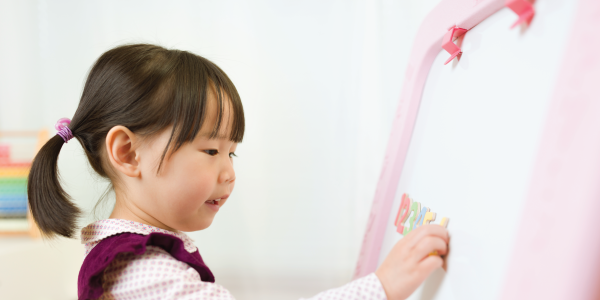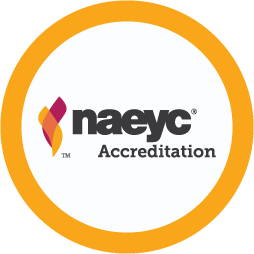Embracing Linguistic Diversity to Support Multilingual Learners

You are here
During one of my first years as an educator in an inclusive preschool program, I had an opportunity to engage with many families from diverse backgrounds. Four of the 10 children in my class spoke Spanish at home, one spoke Yiddish, and the rest were monolingual English speakers. I also had one teaching assistant who spoke Hindi. While everyone shared English as a common language, I worked to ensure that each child saw their home language as a strength and represented in our setting.
According to US Census data, about a quarter of children in preschool settings are multilingual learners, meaning they’re learning two or more languages simultaneously at home and/or at school. As educators, it’s important to encourage these children: research shows improved academic outcomes for children who have the opportunity to learn more than one language during the early years. In addition, supporting the development of a child’s home language while promoting English proficiency is part of equitable teaching.
As a preschool educator working to integrate the cultural backgrounds of all the children in my setting, I had to be intentional about the lessons and activities I planned throughout the day. I understood how important it was for children to see their families, languages, and cultures reflected in our setting and learning materials. These, after all, are strengths that should be celebrated.
So how can early childhood educators foster language development and support multilingual preschoolers in inclusive settings? Here are a few strategies based on the research and my experiences.
Create a Language-Rich Environment That Includes Home Languages
Research has shown that multilingual learners thrive when they have the opportunity to share their home languages with others and transfer what they know from one language to another. Early childhood educators can create these language-rich environments in a number of ways.
Embrace Many Languages in Your Setting
Children learn from their surroundings. When educators and family members describe the people, activities, and materials in their environments, children are likely to use the same words themselves. This builds strong language and comprehension skills.
To build multilingual learners’ vocabularies, encourage them to use descriptive words—such as colors, locations, amounts, and shapes—in English or their home languages. For example, when asking a multilingual learner whose home language is Spanish to describe a chair, allow the child to respond by saying “rojo, grande, and pesada” to describe the chair as red, big, and heavy. The child also might translanguage, or move fluidly through multiple languages, by saying “The chair is rojo y grande.” Translanguaging enhances a child’s ability to learn, understand, and make connections. It also honors the way language learning develops: a child often understands a new language before they can speak it.
Educators can encourage children to describe their observations as they engage with materials and in learning experiences: What do they see while outside on the playground? What do they notice in the pages of a book? Educators can scaffold these observations by providing verbal prompts or modeling extensions of words or phrases.
Engage in Multilingual Conversations
Early childhood educators can assist with multilingual learners’ language development by engaging in language-rich conversations. Different questioning techniques will allow children to extend their language. Open-ended questions, for example, require longer sentence strings and more information about people, places, things, or experiences. These kinds of questions encourage children to use more language.
If educators are fluent in a child’s home language, they can ask questions in both languages. If an educator is only fluent in English, they can continue to encourage children to use their home languages. For example, I used to play a math game with children using a large, inflatable die. Children took turns tossing the die to each other and identifying the number of dots on its face. I asked questions like “How many dots are there?” Children could say “six dots” or “seis puntos,” followed by whether it was “more, less, or the same as” (or “más, menos, o misma que”) compared to the previous child’s number. Using visuals and explanations to support the use of home languages while including monolingual English speakers encourages inclusion and the language development of all learners.

Represent Children’s Languages with Environmental Print
Environmental print includes the print and other symbols found in everyday, physical environments. During their early years, children start to recognize print by identifying logos, labels and symbols on cereal boxes, building and street signs, and the names of snacks, among other representations.
When used intentionally by educators, environmental print can help children, including multilingual learners, investigate how print works and how letters and sounds link to form specific words. Associating letter names and sounds with labels or symbols (such as /m/ when seeing the M&M’s label on a candy wrapper or in the arc of the McDonald’s logo) provides a meaningful context for introducing these skills. Collecting familiar labels in a portable flip book can help children remember the sounds, names, and symbols associated with them.
Another way to support multilingual learning is to explore environmental print in children’s home languages. Teachers can label the objects in their settings with pictures and words in English and children’s home languages. Families can participate in activities to support this: They can share environmental print from their favorite snacks, foods, or games. They can also point out to their children signs around the community that are in English and their home language, such as baño for bathroom, biblioteca for library, or iglesia for church. With environmental print in multiple languages, all learners will be able to explore the similarities and differences in English and their home languages.
Encourage Home Language Use Across Content Areas
It takes intentional planning to honor children’s home languages and build on their strengths. Early childhood educators should look for ways to thread multilingual learners’ languages across content areas and throughout the day.
Develop Language Through Art
Displaying pictures, paintings, posters, and artifacts that represent children’s and families’ cultures can help establish a sense of acceptance and belonging. It can also develop a deeper association with a child’s home language.
Teachers can encourage children to talk about art, using English and their home languages. They can model ways to describe art by using words about its shape, color, patterns, or texture (“This vase is brown, or marrón. It also feels rough. In Spanish, this is called áspero”). Families can help provide the related vocabulary if necessary.
Educators can also include words or phrases that describe specific attributes of artwork (large, small, round, sharp). They can encourage children to draw pictures of what they see and explain their drawings to peers or family members. Describing art that represents themselves and their cultures builds children’s vocabulary and helps them transfer those new words to conversations.
Provide Opportunities for Storytelling and Dramatic Play
Books, oral storytelling, and dramatic play provide opportunities for children to build language skills and for teachers to involve families. Educators can read a book in English, then ask families to read it in their home languages. This helps children hear and begin to understand words, sounds, and phrases in both languages.
Educators can also foster language development by asking children to make predictions during interactive read alouds and to talk about the people, places, and events in a book. They can extend the learning by asking children to retell the story or to act out specific scenes, characters, or events. They can encourage children to engage in the same dramatic play at home, then ask how the reenactments were similar or different.
Foster Language Development Through Cooking
The children in my classroom enjoyed cooking. Each week, we engaged in a cooking activity that went along with a learning theme. Children learned new words and practiced using verbs to explain what we were doing, both in English (layering the fruit, kneading the dough, folding the batter) and in their home languages. While building language skills, we also practiced numeracy by sequencing the steps required to complete each recipe and identifying which child was first, next, or last to finish a step in the cooking process.
Conclusion
Supporting multilingual learners by honoring their home languages and cultures is part of developmentally appropriate and equitable practice. In addition to cultivating academically oriented skills, this inclusion supports children’s social, emotional, and behavioral success.
Consider the strategies you use to develop the language of multilingual learners. If you haven’t implemented any, think about the ways you could scaffold multilingual learners and how you might work more closely with families. The goal is to ensure that multiple languages are positively and accurately represented in your early learning setting.
Photographs: © Getty Images
Copyright © 2024 by the National Association for the Education of Young Children. See permissions and reprints online at NAEYC.org/resources/permissions.
 This article supports the following NAEYC Early Learning Programs standards and topics
This article supports the following NAEYC Early Learning Programs standards and topics
Standard 2: Curriculum
2D: Language Development
2E: Early Literacy
Standard 4: Assessment of Child Progress
4D: Adapting Curriculum, Individualizing Teaching, and Informing Program Development
Standard 7: Families
7A: Knowing and Understanding the Program’s Families
Koryne Nnoli, PhD, is an assistant professor of exceptional education at Morgan State University in Baltimore, Maryland.